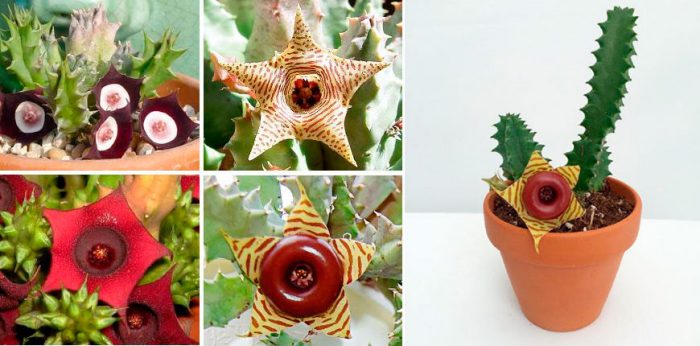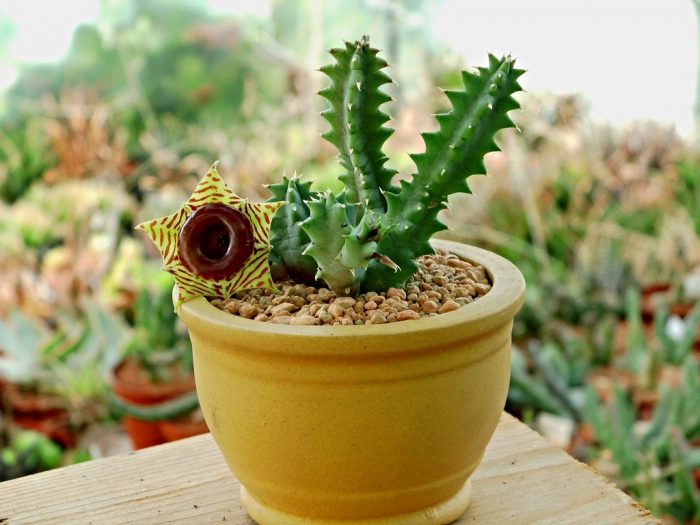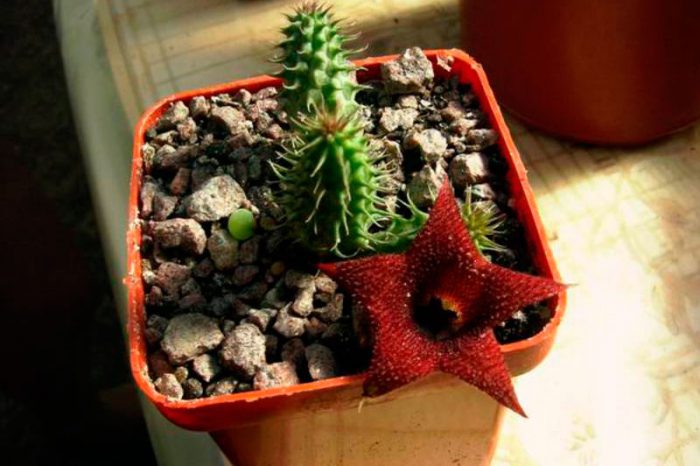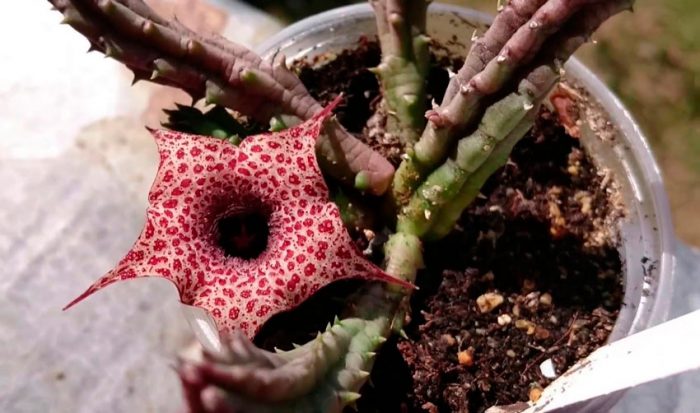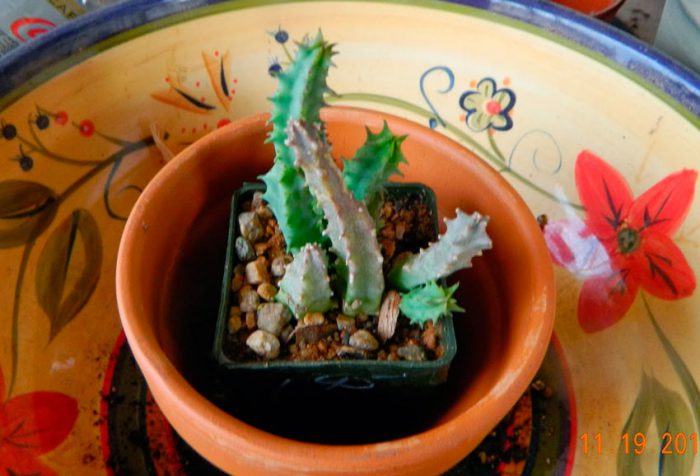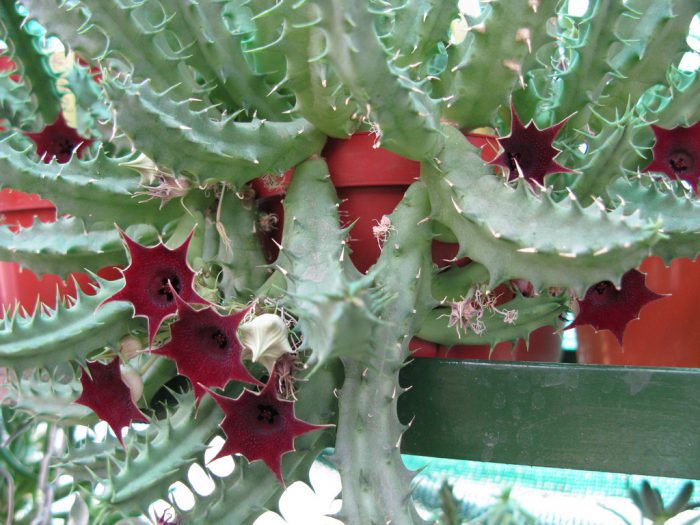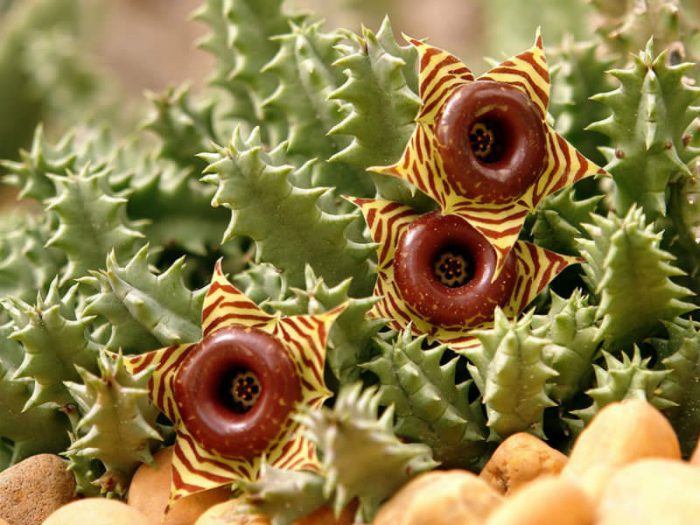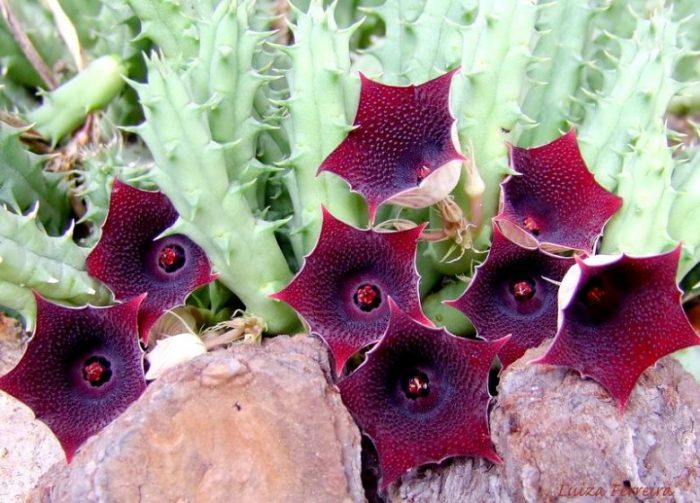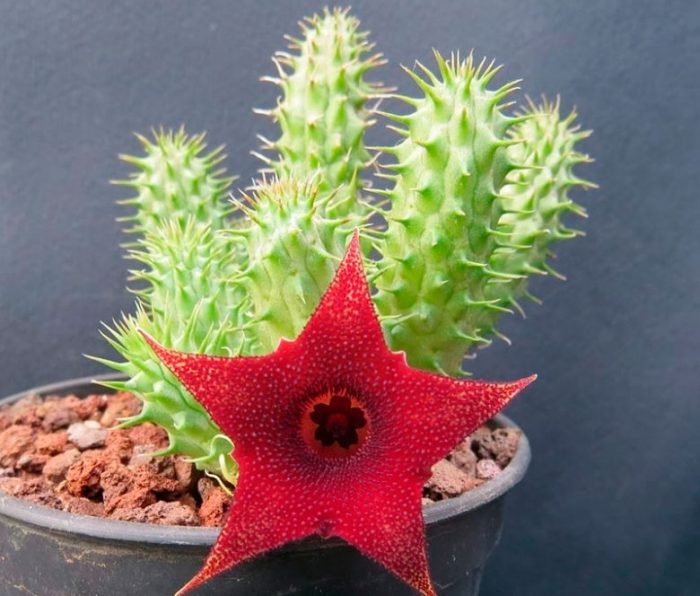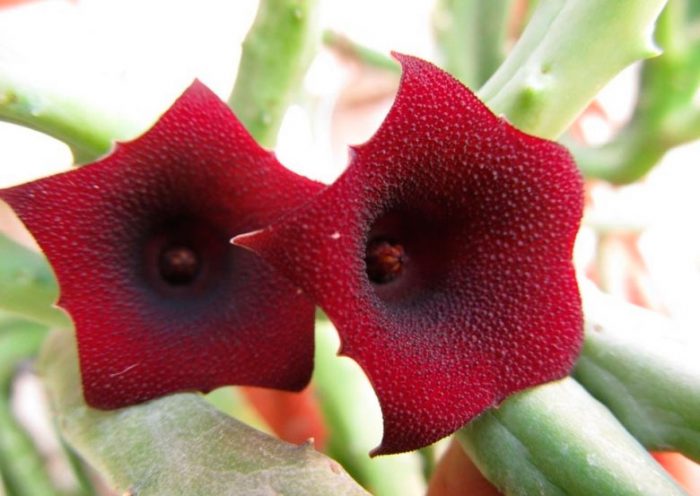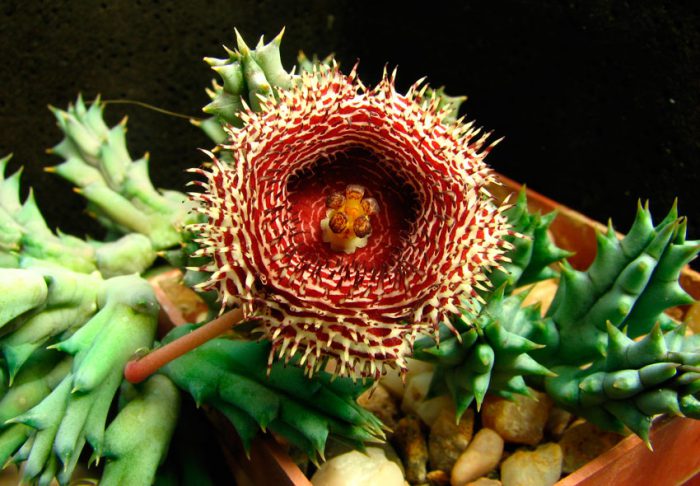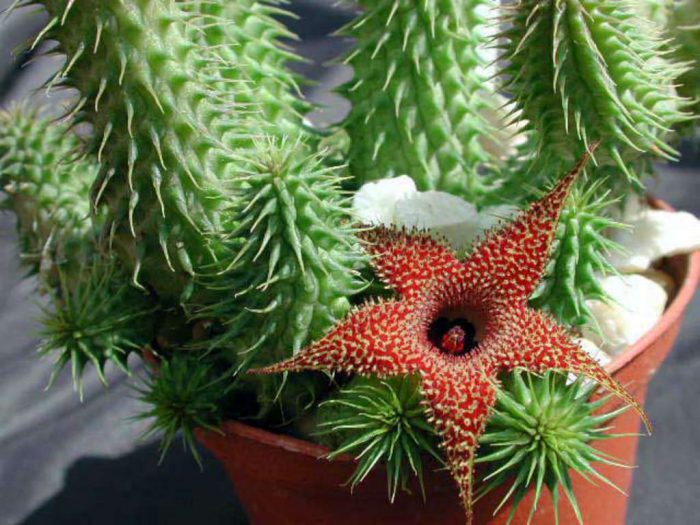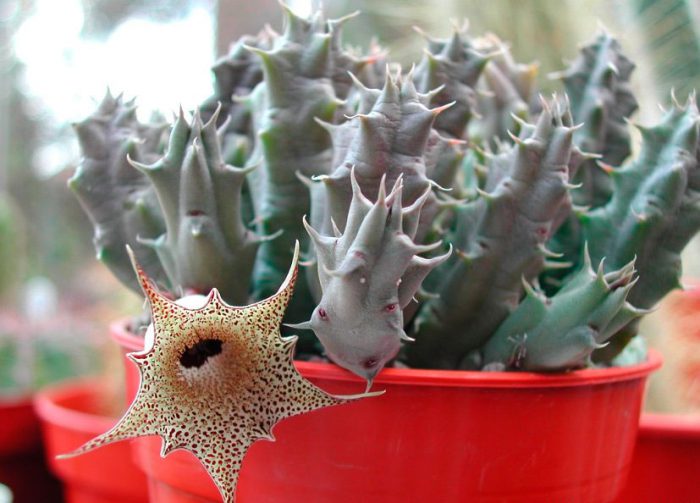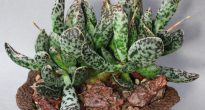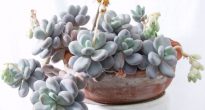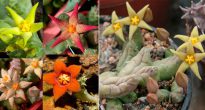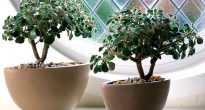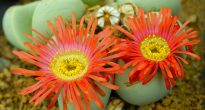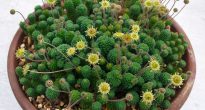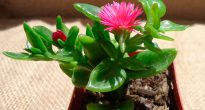Kind of like guernia (Huernia) belongs to the Asclepiadaceae family. According to various sources, it unites 40-60 plant species, which are represented by succulents. They are found naturally in the rocky arid regions of East and South Africa, as well as on the Arabian Peninsula.
A characteristic feature of all species is not very high, branched at the base of the stem, which forms rather large bushes. So, their diameter can exceed the height of the plant itself by 2 or 3 times. Thick juicy shoots have 4-10 edges, and they have fleshy sharp teeth of a conical shape. These teeth have a wide base, and can be up to 1 centimeter long. The surface of bare shoots is shiny, smooth, and in different species it can be painted in different color shades from brown to deep green.
The plant blooms during the summer and early autumn period, and the duration of flowering itself varies from 2 to 3 months. The flowers are either collected in low-flowered inflorescences or single, are located in the lower part of the shoot in the axils of the teeth (two-year or annual growth) closer to its base. Short pedicels in length, as a rule, reach 5–20 millimeters. Accreted large sepals have a rich color. They form a wide tube with a large bend having five lobes, while some species have additional pointed projections at the places where the lobes diverge. The petals are not pronounced, and they are deep in the tube, where there are also reproductive organs. In different species, the corolla has a different color and shape. So, for example, in some species it may resemble a deep cup or a bell, while in others it may resemble a shaggy jellyfish or starfish. In most species, the unpleasant smell of carrion comes from the flowers.
Content
- 1 Guernia care at home
- 2 Main types
- 2.1 Guernia keniensis (Huernia keniensis)
- 2.2 Guernia striped (Huernia zebrina)
- 2.3 Large-fruited Guernia (Huernia macrocarpa)
- 2.4 Guernia rough or thorny (Huernia aspera)
- 2.5 Guernia primulina (Huernia primulina)
- 2.6 Hanging guernia (Huernia pendula)
- 2.7 Guernia prickly (Huernia hystrix)
- 2.8 Guernia hairy (Huernia pillansii)
- 2.9 Guernia boleana
Guernia care at home
Such a plant is quite undemanding to care for and even inexperienced growers can easily grow it.
Illumination
This plant is light-requiring and therefore needs a place with good lighting. It is good if the direct rays of the sun fall on the bush in the evening and in the morning.For placement, it is better to prefer western and eastern orientation windows. When placed on a south window, you will need shading from midday sunlight in the summer. If you place the guernia on a north-facing window, then, due to poor lighting, the bush will become elongated, and flowering may not occur at all.
With the onset of the autumn and winter periods, the flower needs additional lighting with special phytolamps.
It is worth remembering that Guernia has a habit of having a fixed lighting angle. And this means that if a flowering plant is turned around its axis or moved to a place with a different intensity of illumination (lighter or darker), then it quickly sheds both buds and already blossoming flowers.
Temperature regime
In summer, such a flower grows normally and develops at a temperature of 22 to 27 degrees. From mid-spring to the last September days, it is recommended to move it outside (to the balcony, to the garden), choosing for it a place protected from precipitation in partial shade.
In winter, such a plant needs coolness. It is best if its temperature is kept at a level of 5 to 10 degrees.
How to water
In the spring and summer, water should be moderate. Guernia does not need very long dry periods. To do this, it is necessary to systematically dry the substrate by about ½ part. In no case should the stagnation of water in the soil and its waterlogging be allowed. The fact is that this can cause the development of rot on the root system and stems, while the flower itself, in this case, dies after about two days.
In winter, you need to water very sparsely.
Often, after the end of the dormant period for a given succulent, flower growers may face such a problem as not absorbing moisture from the dried soil. In this case, experienced florists recommend resorting to one little trick. Pour water into a deep and wide enough container and immerse the pot in it. After 20-30 minutes (when air bubbles stop coming out) it should be removed from the water. Drain off any excess liquid thoroughly. Then the flower is put in place and watered in the usual summer mode.
Humidity
This succulent quite easily tolerates not very high air humidity, so you do not need to moisten it additionally.
Earth mix
A suitable substrate should be well permeable to water and air, be loose, slightly alkaline and have an acidity of pH 7.5–8.5. For planting, you can use a commercial soil mix for succulents, but it is recommended to add a small amount of fine gravel (diameter from 3 to 4 millimeters) to it. You can do this mixture yourself. To do this, it is necessary to combine sheet and clay-sod soil, small gravel and coarse river sand.
For planting, it is recommended to use a low, but wide pot, since the roots of the plant are underdeveloped, but it itself grows relatively strongly. Do not forget to make a good drainage layer using pebbles or expanded clay for this.
Top dressing
The plant is fed from the beginning of intensive growth to the end of the summer period 1 time in 4 weeks. To do this, use specialized fertilizers for succulents and cacti. During the dormant period, it is not necessary to feed the plant.
Reproduction methods
Can be propagated quite simply by stem cuttings. To do this, they must be carefully separated from the mother plant and left in the open air for 2 days to dry. Then it is planted in the prepared soil mixture. As a rule, the stalk blooms in the same year.
In March, you can sow seeds in a mixture of peat and sand. Before germination, the container with seeds must be placed in a light mini-greenhouse.
Transplant features
Annual transplant in spring is recommended. In this case, they take a container of slightly larger diameter than the previous one. Experienced growers recommend removing the old, overgrown shoot and renewing the guernia from the cuttings.
Pests and diseases
Often settles on such a flower mealybugpreferring a loose substrate. It is recommended to fight such a pest with special insecticides (for example, Aktara or Intavir).
The most common disease is stem and root rot. When it appears, the guernia, as a rule, dies. In this regard, the plant must be watered very carefully and do not forget to arrange dry periods.
Main types
At home, flower growers grow a fairly large number of different types of guernia. At the same time, thanks to breeders, a large number of hybrids and varieties were born.
Guernia keniensis (Huernia keniensis)
This plant is semi-ample. It has relatively long (up to 30 centimeters) creeping stems with five ribs. On the ribs there are sharp teeth bent downwards. The inflorescences consist of 2-5 velvety flowers, painted in purple-red color. Almost entirely fused sepals represent a wide funnel, three centimeters in diameter. It has long teeth (sepal tips) in the shape of a triangle, while it happens that they are bent back. Inside and outside, the sepals are covered with a huge number of outgrowths-papillae.
This species has several varieties, which differ, as a rule, in the shape and size of the corolla. The flower of the "Grandiflora" variety has a diameter of 5 centimeters, while the "Globosa" variety has a spherical corolla tube.
Guernia striped (Huernia zebrina)
This species is very compact. So, the height of the stem is only 10 centimeters, and the width is 2 centimeters. Erect shoots have clearly distinguishable ribs, of which there are 4 pieces. Being in a shaded place, the stem turns into a pale green color, and if it is transferred to the sun, it turns into burgundy green. Single flowers are quite large (up to 7 centimeters in diameter). The corolla shape is rather unusual. So, the glossy mouth of the tube, painted in maroon color, turns into a highly convex regular ring (almost torus) of the same color shade. From under this ring peeps out a five-pointed broad-rayed asterisk, consisting of accrete sepals of yellow color, on the surface of which there are many transversely arranged burgundy stripes.
Large-fruited Guernia (Huernia macrocarpa)
This species is medium-sized. Its erect stems, painted in a greenish-bluish color, turn purple in bright sunlight, and reach a height of 20 centimeters. The shoots have 7 ribs that have slightly curved teeth. There are both single flowers and those collected in small-flowered inflorescences of 2–5 pieces. A small corolla with a diameter of two centimeters has a wide bell-shaped shape. The shape of the bend is a regular pentagon, while at the place where the sepals grow together there are tiny denticles. It has an uneven, maroon color, while it has a pronounced mottling.
There are different varieties, differing in the color of the flower itself, as well as in the shape of the teeth.
Guernia rough or thorny (Huernia aspera)
This species is also medium-sized, but it has thin stems (15 millimeters wide). Pale green shoots have 5 ribs. The rapidly tapering teeth are needle-shaped almost from the base. Flowers are either single, or are part of few-flowered inflorescences (2–5 pieces each). The corolla tube is broadly bell-shaped, and the bend is a regular five-pointed star. Inside it is painted in a burgundy-reddish color, and on the surface there are many long growths-papillae of a similar color shade.
The difference between varieties in color of flowers - from dark purple to deep red.
Guernia primulina (Huernia primulina)
This small species has the ability to grow strongly. In height, the bush can reach only 8 centimeters, while the thickness of its shoots is 1.5 centimeters. An adult shrub can reach 30 centimeters in diameter.Creeping four- or pentahedral stems are painted greenish-gray. Small teeth taper sharply towards the tip. The length of the pedicels is 2.5 centimeters. Flowers are often part of low-flowered inflorescences (3-8 pieces each). The inside of the tube is painted burgundy, and this surface is highly speckled. The creamy yellow limb consists of half-fused sepals with a wide-triangular shape. The bend in diameter is 2 to 3 centimeters.
Hanging guernia (Huernia pendula)
This is an ampelous view. Its drooping stems are 150 centimeters long. The cylindrical shoots have a diameter of 9 centimeters. The ribs on them are almost indistinguishable, while the teeth look like not very large tubercles. The flowers are relatively small, only 2 centimeters in diameter. They are found in low-flowered inflorescences (from 2 to 5 pieces). The reddish-burgundy limb is similar in shape to a wide-beam star (almost a pentagon), while its rays are slightly bent back. The mouth of the tube is colored in a darker shade, almost black and burgundy.
Guernia prickly (Huernia hystrix)
This type is of the greatest interest. The bush is rather small, so, in height it reaches 5-12 centimeters, but in width - 30 centimeters and even more. The drooping, pale green pentahedral shoots have thick, upward-facing teeth. The pedicels are 6 centimeters long. The corolla is similar in shape to a bird's nest. So, the sepals are very strongly bent back, while their tips are connected at the pedicel, as a result of which a kind of donut or torus is formed, which is attached to a wide (about 1.5 centimeters in diameter) tube. In addition, on the surface of the corolla there are a lot of fleshy, thick growths-papillae, reaching from 3.5 to 5.5 millimeters in length, which is why the flower looks prickly-shaggy. The color of the flowers, together with the papillae, is striped, whitish-burgundy.
Guernia hairy (Huernia pillansii)
Also a very interesting view. Due to the stems, this succulent is similar to a cactus, painted in a rich green color and having soft thick needles that turn red from sunlight. The diameter of the shoots is 1.2–2 centimeters, and their length is 20 centimeters. On the stems, as a rule, there are from 9 to 16 ribs (sometimes more), which is why the denticles are located extremely tightly (almost close to each other). The teeth at the base are conical, while they are strongly narrowed almost at the very surface and leave thin half-centimeter tails, making the bush look fluffy.
The flowers are similar to the starfish, but only with the mouth opening upside down, while the large number of rather long growths-papillae on the sepals enhances this similarity. Flowers can be painted in different colors, for example, yellow, brownish-red, some have reddish growths on the yellow surface, or vice versa. The size of the corolla can vary from 2.5 to 5 centimeters.
Guernia boleana
The dark green shoots of this plant reach a height of about 10 centimeters. The pale yellow flowers are decorated with dense burgundy specks. Sepals have grown together by ½ part and formed a wide tube. The flat bend at the rim has a two-centimeter diameter and the shape of a regular five-pointed star.

